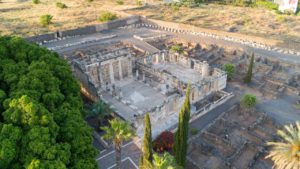During pilgrimages, guides habitually ask the accompanying priest to read a Gospel passage related to the place the pilgrims are visiting. At the basilica of the Annunciation, the Grotto of the Nativity, or the Church of the Transfiguration, to cite three examples, it is easy to choose the passage. But what should one read in Capernaum, where Jesus spent the majority of his public life?

Capernaum photo by Eyal Asaf
Many events took place there: the call of Peter, Andrew, James and John while they were working among the boats and nets (Mt 4, 18-22; Mc 1, 16-20; Lc 5, 1-11), Mathew’s vocation while he was working at the Customs House, and subsequently, the feast at his home with other publicans (Mt 9, 9-13; Mc 2, 13-17; Lc 5, 27-32); the casting out of a demon that had possessed a man (Mc 1, 21-28; Lc 4, 31-37); the many healings, of the centurion’s servant (Mt 8, 5-13; Lc7, 1-10), Peter’s mother-in-law (Mt 8, 14-15; Mc 1, 29-31; Lc 4, 38-39), the paralytic let down from the roof by his friends (Mt 9, 1-8; Mc 2, 1-12; Lc 5, 17-26), the woman suffering the hemorrhage (Mt 9, 20-22; Mc 5, 25-34; Lc 8, 43-48) and the man with the withered hand (Mt 12,9-14; Mc 3, 1-6; Lc 6, 6-11); the resurrection of Jairus’s daughter (Mt 9, 18-26; Mc 5, 21-43; Lc 8, 40-56); the payment of the Temple tax with the coin found in the mouth of a fish (Mt 17, 24-27); the discourse on the Bread of Life at the synagogue (Jn 6, 24-59); etc.
My experience accompanying groups of pilgrims leads me to recommend one particular reading: the beginning of the Gospel according to Saint Mark, from verse 14 of the first chapter until verse 12 of the second. Read there, under the shade of the sycamore trees, among the ruins of Capernaum, it all suddenly makes sense, gains relevance, comes to life. It is one of the best examples of how the Gospels are read with different eyes after one has made a pilgrimage to the Holy Land.
Father Jesús Gil
